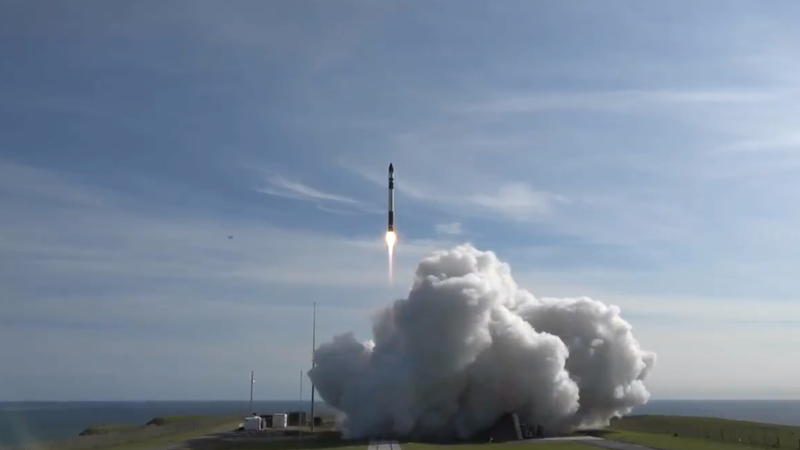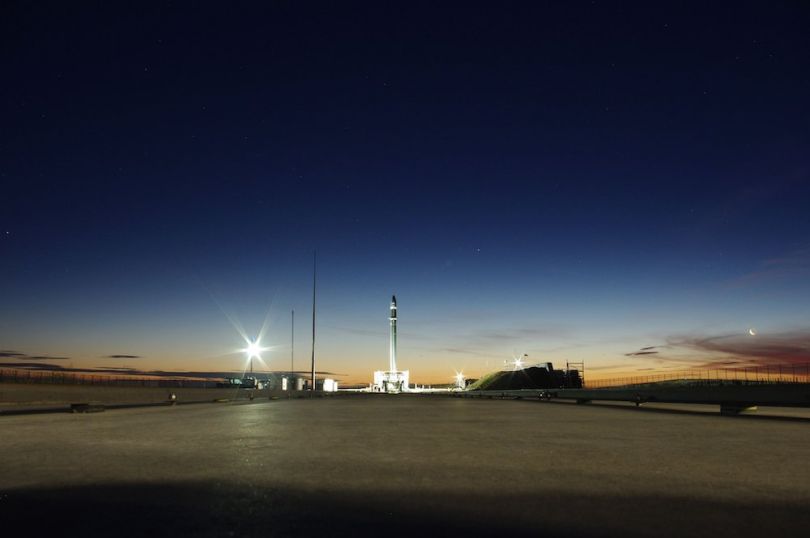New Mars Forums
You are not logged in.
- Topics: Active | Unanswered
Announcement
#1 2018-11-11 21:48:56
- SpaceNut
- Administrator
- From: New Hampshire
- Registered: 2004-07-22
- Posts: 29,905
Rocket Lab launch in New Zealand brings quick, cheap space access
Successful first launch
Rocket Lab launch in New Zealand brings quick, cheap space access
Rocket Lab is a private American aerospace manufacturer and smallsat launcher with a wholly owned New Zealand subsidiary. It has developed a suborbital sounding rocket named Ātea and currently operates a lightweight orbital rocket known as the Electron, which provides dedicated launches for smallsats and cubesats.
http://en.wikipedia.org/wiki/Rocket_Lab
Rocket Lab Completes First Commercial Launch of Its Electron Rocket

two-stage, $5.7 million Electron rocket launched from Rocket Lab’s complex in New Zealand,
standing more than 55 feet (17 meters) tall,
First stage is with nine main engines powered by kerosene,
Second stage single Rutherford engine (a mostly 3D-printed design with an electric-pump-fed engine)
Rocket Lab’s Curie kick stage burns a “green” non-toxic liquid monopropellant.
https://www.zdnet.com/article/its-busin … w-zealand/
"We have a burgeoning customer manifest, so we're moving onto the next mission within a few weeks -- the incredibly exciting ELaNa 19 mission for NASA in December."
Rocket Lab added that it has a private launch complex licensed for 120 launches each year, and previously said it aims to complete a launch each fortnight in 2019, and weekly in 2020. Its rockets use 3D-printed engines and can carry payloads of up to about 150 kilograms.

Offline
Like button can go here
#2 2018-11-12 02:26:56
- louis
- Member
- From: UK
- Registered: 2008-03-24
- Posts: 7,208
Re: Rocket Lab launch in New Zealand brings quick, cheap space access
Refreshing to have a countdown in a different accent: Teen, noin, ate, seen, sex, foiv, foe, thwee, toe, warn! ![]()
Rocket Lab are impressive and this just proves it! ![]()
Let's Go to Mars...Google on: Fast Track to Mars blogspot.com
Offline
Like button can go here
#3 2019-11-26 13:31:56
- SpaceNut
- Administrator
- From: New Hampshire
- Registered: 2004-07-22
- Posts: 29,905
Re: Rocket Lab launch in New Zealand brings quick, cheap space access
Offline
Like button can go here
#4 2021-01-30 21:02:55
- SpaceNut
- Administrator
- From: New Hampshire
- Registered: 2004-07-22
- Posts: 29,905
Re: Rocket Lab launch in New Zealand brings quick, cheap space access
Another One Leaves The Crust begins busy year for Rocket Lab
This was the 18th launch of the Electron rocket overall, the first of at least nine announced missions for this year, and the first mission for the company demonstrating a rapid contract to launch period.

Offline
Like button can go here
#5 2021-01-31 18:55:40
- SpaceNut
- Administrator
- From: New Hampshire
- Registered: 2004-07-22
- Posts: 29,905
Re: Rocket Lab launch in New Zealand brings quick, cheap space access
Rocket Lab demonstrates new orbital maneuvering capability
successfully burning the Curie engine for more than twice the standard mission duration and delivering more than 1,700 km of perigee change.
On January 20, 2021, Rocket Lab successfully launched a communications satellite for European space technology company, OHB Group, deploying the 50 kg class GMS-T satellite to a 1,200 km circular orbit - around 700 km higher than most Electron missions to date.
After separating from Electron's second stage into an elliptical transfer orbit, the Kick Stage's 3D printed Curie engine performed two separate burns; one to raise OHB Group's satellite to a 1,200 km circular orbit, and a second burn to lower the Kick Stage's perigee after payload deployment, speeding up the de-orbit process to avoid the Kick Stage becoming long-term orbital debris.Across the two maneuvers, Curie completed more than 267 seconds of total burn time and delivered 1,722 km of perigee change, ascending 982 km and descending 740 km. The complex maneuvers saw Curie burn for more than twice the standard Kick Stage mission profile to low Earth orbit. The extended burn time was made possible thanks to the adaptable design of the Kick Stage which enabled engineers to double the standard number of propellant tanks from four to eight, delivering more on-orbit performance.
Offline
Like button can go here
#6 2021-01-31 20:33:58
- louis
- Member
- From: UK
- Registered: 2008-03-24
- Posts: 7,208
Re: Rocket Lab launch in New Zealand brings quick, cheap space access
They are doing well and definitely occupy a niche in the market but not in the Space X or Bezos league.
Let's Go to Mars...Google on: Fast Track to Mars blogspot.com
Offline
Like button can go here
#7 2021-11-29 03:52:20
- Mars_B4_Moon
- Member
- Registered: 2006-03-23
- Posts: 9,776
Re: Rocket Lab launch in New Zealand brings quick, cheap space access
Rocket Lab confirms helicopter capture attempt for next recovery mission
Offline
Like button can go here
#8 2021-11-30 12:28:14
- Void
- Member
- Registered: 2011-12-29
- Posts: 9,073
Re: Rocket Lab launch in New Zealand brings quick, cheap space access
While helicopters seem like a good start, I would like to see the development of air breathing drones to retrieve falling cargo, and eventually even crewed ships.
I guess one thing would be if a drone with a platform could maneuver under the falling 2nd stage and grasp it, or if it would grab a tag line above, with a drogue chute.
This could then remove the requirement for landing burns, and so then also propellants. To send a ship up without landing propellants, would then remove the need for the propellants to get the landing tanks and the propellants in them to orbit.
If they do catch the electron with a helicopter, then eventually they may indeed build an air breathing drone for that purpose. That way no salt water in the engines.
Done.
Last edited by Void (2021-11-30 12:30:39)
Is it possible that the root of political science claims is to produce white collar jobs for people who paid for an education and do not want a real job?
Offline
Like button can go here
#9 2021-11-30 13:29:03
- tahanson43206
- Moderator
- Registered: 2018-04-27
- Posts: 23,427
Re: Rocket Lab launch in New Zealand brings quick, cheap space access
For Void re #8
If a helicopter catches the stage in mid-air, how would salt get into the engines?
(th)
Offline
Like button can go here
#10 2021-11-30 19:50:04
- Void
- Member
- Registered: 2011-12-29
- Posts: 9,073
Re: Rocket Lab launch in New Zealand brings quick, cheap space access
I suppose I could have phrased it better. If a helicopter OR a drone fetches a falling object so that it does not fall into water/salty water, then no salt water in the devices.
A helicopter is a good start, in my opinion.
Elon Musk has started calling the launch pad "Stage 0".
Super Heavy is "Stage 1".
Starship is "Stage 2"
A flying catching device would then be "Stage -1"????
I suppose if you could make a special "Super Heavy Mini", it might be able to lock onto the falling Starship, and then land it with its propulsion.
However, that is much too ambitious in my opinion. The method of Starship descent, horizontal, well maybe someday.
Actually, you would perhaps want air breathing engines for that, and of course a much smaller "Catcher" than the Superheavy "Booster".
It might burn an improved jet fuel like the Falcon 9, but no liquid Oxygen. So, then to not be as fussy as cryogenic rockets.
But if you could then you might even eliminate the header tanks in such a "Starship".
As I have indicated, I think that that is far too ambitious, but maybe someday.
AI is getting better, probably will be able to outdo human pilots for reaction time and calculations. Perhaps the Tesla self-driving car software will eventually apply in some modified form.
So now they are going to try to catch the Electron rocket with a helicopter. But that then puts a pilot's life at some risk. Eventually they may go to a drone with AI.
I don't care to look up the details, but I believe that there is a 3 company deal in the works, where SpaceX will launch, another companies "Buss", and that Buss will deploy multiple mini-factories, to build zero g products. Then these "Capsules" will come down on their own to the surface. I suppose that will involve heat shields and parachutes.
Now if you had a jet fueled air breathing drone, perhaps it could grab them by some means and deliver them directly to a desired destination.
It is my opinion, that the Fairings for Falcon 9 might be fetched that way, using the parachute as a lifting device, while the drone would provide push or pull.
Done.
Last edited by Void (2021-11-30 20:08:11)
Is it possible that the root of political science claims is to produce white collar jobs for people who paid for an education and do not want a real job?
Offline
Like button can go here
#11 2021-12-01 04:30:32
- Calliban
- Member
- From: Northern England, UK
- Registered: 2019-08-18
- Posts: 4,269
Re: Rocket Lab launch in New Zealand brings quick, cheap space access
You intend to catch a rocket stage, weighing several tonnes and falling at 100+ mph, using a helicopter? A dangerous mission, I would suggest.
Last edited by Calliban (2021-12-01 04:32:49)
"Plan and prepare for every possibility, and you will never act. It is nobler to have courage as we stumble into half the things we fear than to analyse every possible obstacle and begin nothing. Great things are achieved by embracing great dangers."
Offline
Like button can go here
#12 2021-12-01 11:42:15
- Void
- Member
- Registered: 2011-12-29
- Posts: 9,073
Re: Rocket Lab launch in New Zealand brings quick, cheap space access
Well, of course I will only post. I won't be catching any rocket boosters myself ![]()
Quote Calliban:
You intend to catch a rocket stage, weighing several tonnes and falling at 100+ mph, using a helicopter? A dangerous mission, I would suggest.
mid-air retrieval:
https://en.wikipedia.org/wiki/Mid-air_retrieval
I have become aware that there are rising companies that may use a large rocket to distribute an array of small micro-gravity factories to orbit. Then when they have produced what they intended, these will be caused to enter the Earth's atmosphere. I presume they will use a ablative heat shield, and parachute to slow down.
This would seem to have an advantage(s), as a device with a small surface area relative to mass and volume, will loft them to orbit. However on the way down, devices with a relatively large surface area relative to mass and volume will be used. This has some advantage.
The disadvantages are;
-That each capsule will have to be lofted as protection for each "Factory Run".
-That it is an additional task to collect these things to a desire location.
Will they drop into a desert, or the ocean?
It could be that some highly reactive drones could be developed to fly them to where they are wanted.
Quick reactions/reflexes, per AI.
Quick response per catching the falling load.
I anticipate that this could be an expanding development, provided that the materials manufactured in microgravity will pay off for the effort.
To be sufficiently responsive these things may need rocket thrusters.
Done.
Last edited by Void (2021-12-01 11:56:01)
Is it possible that the root of political science claims is to produce white collar jobs for people who paid for an education and do not want a real job?
Offline
Like button can go here
